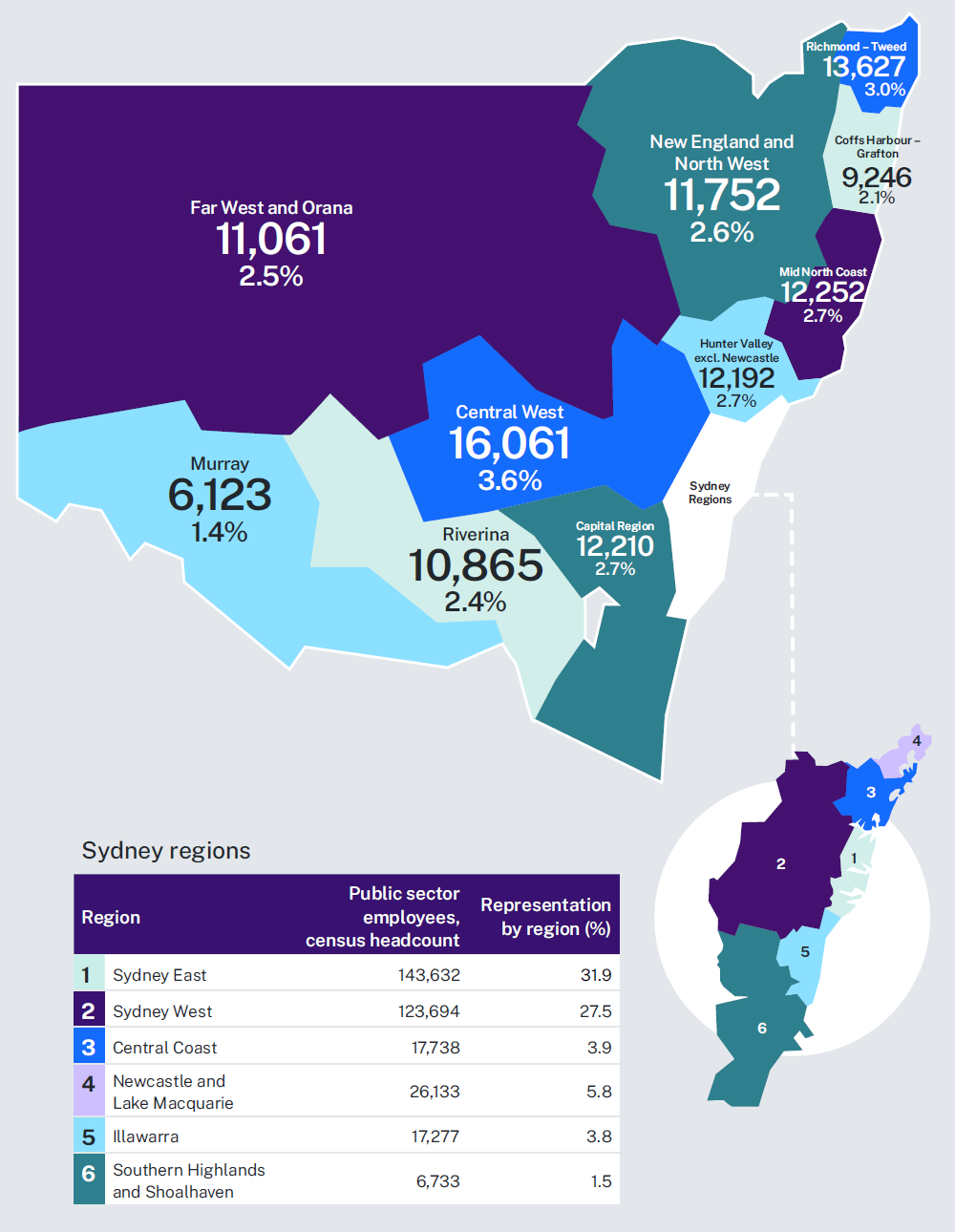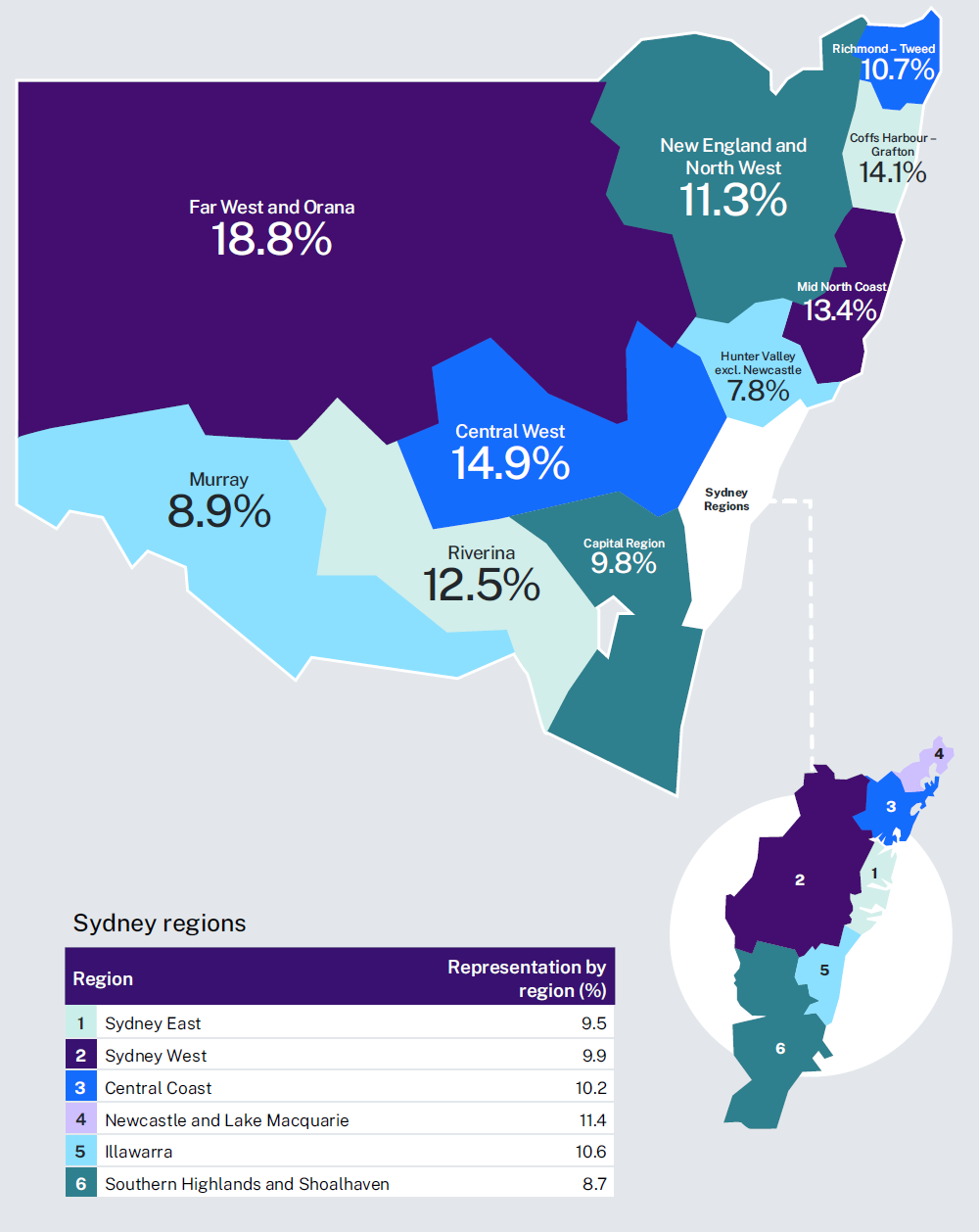34%
of employees were located in regional areas at census date
(–0.4pp vs 2022)
40.7%
of employees were located outside Sydney at census date
(–0.4pp vs 2022)
Note: 'pp' stands for percentage points.
The NSW public sector is the largest employer in Australia, accounting for more than 10% of employment in the state. While a majority of roles are located in metropolitan areas, the NSW public sector provides a significant proportion of all employment in regional NSW.1
This analysis is based on employees’ work locations in the Workforce Profile data submitted by departments and agencies. It does not reflect any work-from-home arrangements.
In 2023, 34% (+4,968 headcount) of public sector employees worked in regional areas. All Sydney local government areas (LGAs) as well as the Newcastle and Wollongong LGAs are classified as metropolitan.
Comparing Sydney with the rest of the state2, 59.3% of NSW public sector employees worked in Sydney (see Figure 11.1, Sydney East and Sydney West combined), an increase of 0.4pp in 2023 (from 59% in 2022). While most of the public sector workforce was located in Sydney, the proportion of public sector employees working outside Sydney was higher than the proportion of the resident population in these areas (40.7% compared to 37.3%) and has decreased since 2022 (−0.4pp from 41% in 2022).3
Figure 11.1: NSW public sector employees by region, census headcount, 2023

NSW regions
| Region | Census headcount | Representation by region (%) |
|---|---|---|
| Hunter Valley exc Newcastle | 12,192 | 2.7 |
| Mid North Coast | 12,252 | 2.7 |
| New England and North West | 11,752 | 2.6 |
| Far West and Orana | 11,061 | 2.5 |
| Coffs Harbour – Grafton | 9,246 | 2.1 |
| Richmond – Tweed | 13,627 | 3.0 |
| Capital Region | 12,210 | 2.7 |
| Riverina | 10,865 | 2.4 |
| Murray | 6,123 | 1.4 |
| Central West | 16,061 | 3.6 |
Sydney regions
| Region | Public sector employees, census headcount | Representation by region (%) |
|---|---|---|
| Sydney East | 143,632 | 31.9 |
| Sydney West | 123,694 | 27.5 |
| Central Coast | 17,738 | 3.9 |
| Newcastle and Lake Macquarie | 26,133 | 5.8 |
| Illawarra | 17,277 | 3.8 |
| Southern Highlands and Shoalhaven | 6,733 | 1.5 |
Regional profiles
The distribution of government sector census period full-time equivalent (FTE) by service and region is shown in Table 11.1. Regions outside Sydney accounted for 39.3%, while Sydney East and Sydney West together accounted for 60.7%. In line with previous years, the highest proportion of employees in the government sector working outside Sydney were in the Teaching Service (44.3%) and the NSW Health Service (42%), followed by other Crown services (39.7%), the NSW Police Force (35.4%), the Public Service (33.9%) and the Transport Service (24.6%).
Table 11.1: Census period FTE by service and region (government sector), 20234
| Work region | Public Service | NSW Health Service | NSW Police Force | Teaching Service | Transport Service | Other Crown services | Total government sector |
|---|---|---|---|---|---|---|---|
| Capital Region | 2,149 | 3,134 | 647 | 2,260 | 209 | 1,093 | 9,491 |
| Central Coast | 2,503 | 6,401 | 743 | 3,192 | 130 | 1,653 | 14,624 |
| Central West | 3,639 | 4,288 | 547 | 2,357 | 333 | 1,712 | 12,875 |
| Coffs Harbour – Grafton | 1,334 | 2,772 | 279 | 1,455 | 511 | 906 | 7,258 |
| Far West and Orana | 2,292 | 2,974 | 550 | 1,740 | 281 | 1,249 | 9,085 |
| Hunter Valley exc Newcastle | 2,693 | 2,488 | 472 | 2,651 | 85 | 1,403 | 9,791 |
| Illawarra | 1,846 | 5,713 | 640 | 3,110 | 546 | 2,138 | 13,993 |
| Mid North Coast | 1,391 | 3,576 | 400 | 2,200 | 85 | 1,431 | 9,082 |
| Murray | 753 | 1,546 | 290 | 1,168 | 110 | 759 | 4,627 |
| New England and North West | 1,757 | 3,205 | 546 | 2,164 | 177 | 1,470 | 9,319 |
| Newcastle and Lake Macquarie | 3,002 | 9,900 | 784 | 3,857 | 748 | 2,492 | 20,782 |
| Richmond – Tweed | 1,264 | 4,923 | 556 | 2,376 | 149 | 1,357 | 10,625 |
| Riverina | 1,506 | 3,314 | 398 | 1,739 | 334 | 1,214 | 8,506 |
| Southern Highlands and Shoalhaven | 1,005 | 1,816 | 236 | 1,439 | 53 | 783 | 5,332 |
NSW public sector relative to the NSW workforce
The NSW public sector accounted for 10.3% of the approximately 4.4 million people employed in NSW at June 20235.
Analysis of the geographic distribution of NSW public sector employees (including casuals) relative to the overall workforce6 shows where government employment contributed the most to local and regional economies. Figure 11.2 shows that the percentage of employed persons who were NSW public sector employees ranged from 7.8% to 18.8% across the regions in 2023.
Figure 11.2: Public sector employees as a proportion of NSW employed persons by region, 2023

NSW regions
| Region | Percentage |
|---|---|
| Hunter Valley exc Newcastle | 7.8 |
| Southern Highlands and Shoalhaven | 8.7 |
| Murray | 8.9 |
| Sydney East | 9.5 |
| Capital Region | 9.8 |
| Sydney West | 9.9 |
| Central Coast | 10.2 |
| Illawarra | 10.6 |
| Richmond – Tweed | 10.7 |
| New England and North West | 11.3 |
| Newcastle and Lake Macquarie | 11.4 |
| Riverina | 12.5 |
| Mid North Coast | 13.4 |
| Coffs Harbour – Grafton | 14.1 |
| Central West | 14.9 |
| Far West and Orana | 18.8 |
Sydney regions
| Region | Representation by region (%) |
|---|---|
| Sydney East | 9.5 |
| Sydney West | 9.9 |
| Central Coast | 10.2 |
| Newcastle and Lake Macquarie | 11.4 |
| Illawarra | 10.6 |
| Southern Highlands and Shoalhaven | 8.7 |
Notes
1Regional boundaries are based on the Australian Statistical Geography Standard developed by the Australian Bureau of Statistics. The work locations of 2,614 NSW public sector employees were unknown due to Workforce Profile data collection records missing a postcode and/or suburb name, or employees working outside NSW. These employees have not been included in denominators when calculating percentages.
2Statistical Area Level 4, Sydney SA4s grouped, excludes ‘Unknowns’ and ‘Outside NSW’. See Regional reference table in Chapter 12 for more detail.
3Australian Bureau of Statistics (2022) ‘2022 Locality to 2021 SA2 Coding Index' Data by Statistical Area 4 , ABS, accessed 4 October 2022.
40.3% of census period FTE is not mapped to any Australian Bureau of Statistics’ Statistical Area Level 4 (SA4) for NSW because of postcode and/or suburb data that is missing or outside NSW.
5Australian Bureau of Statistics (June 2023), ‘Table 1: RM1 - Labour force status by age, labour market region (ASGS) and sex, October 1998 onwards, [time series spreadsheet], Labour Force, Australia, Detailed, accessed 17 September 2023.
6Including casual employees gives a complete picture of the number of people contributing to the NSW economy and travelling between regions for work.
- Next chapter
Data sources, conventions and limitations